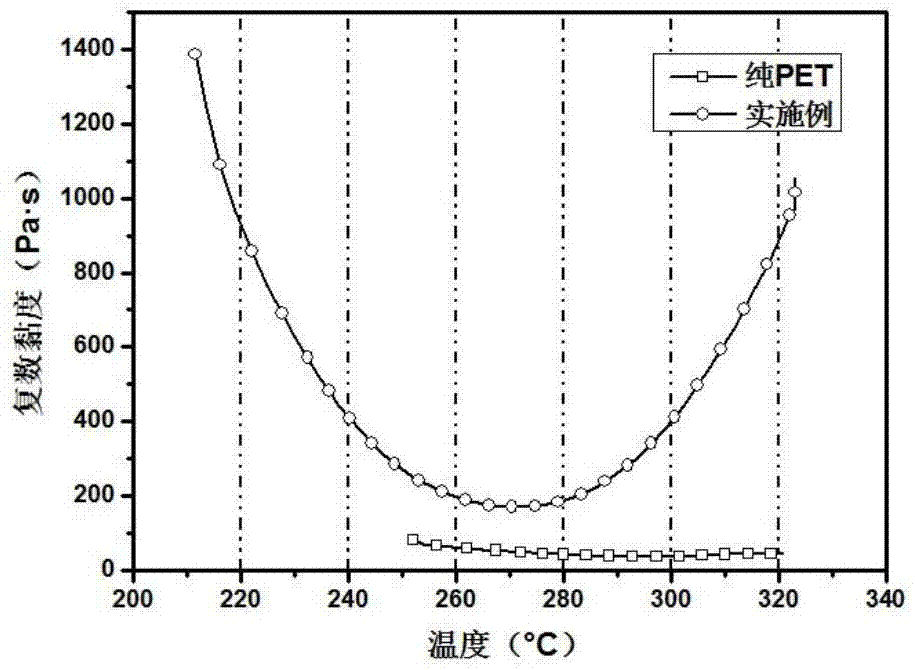Expanded-char-forming, flame-retardant and melt-dropping-resistant copolyester based on polyphenyl ether structure and preparation method of copolyester
A technology of copolyester and polyphenylene ether, which is applied in the field of flame-retardant and droplet-resistant copolyester and its preparation, can solve problems such as personal injury and property loss, and achieve secondary combustion, high char formation efficiency and rate, The effect of excellent flame retardancy and droplet resistance
- Summary
- Abstract
- Description
- Claims
- Application Information
AI Technical Summary
Problems solved by technology
Method used
Image
Examples
Embodiment 1
[0040] 860g of terephthalic acid, 419mL of ethylene glycol, 97.8g of 1,4-bis[4-(2-hydroxyethoxy)phenoxy]benzene and 0.344g of tetrabutyl titanate were added to the reaction kettle, and the Exclude the air in the kettle with nitrogen, pressurize to 0.1MPa; raise the temperature to 240°C within 2 hours to start the esterification reaction, control the pressure in the kettle to 0.3-0.4MPa, after maintaining for 2 hours, the pressure begins to decrease, and the temperature gradually rises to 260 after 1.5 hours ℃, the pressure drops to normal pressure, and the esterification reaction ends; thereafter, the polycondensation reaction is carried out at 260-270 ℃ for 0.5h in low vacuum, and then the temperature is raised to 270 ℃ for high vacuum (pressure <60Pa) polycondensation reaction for 1-3 hours, and the material is discharged , water-cooled.
[0041] The intrinsic viscosity [η] of the copolyester is 0.65dL / g; the limiting oxygen index is 26.0%; the vertical combustion grade is V...
Embodiment 2
[0043] 860g of terephthalic acid, 404mL of ethylene glycol, 195.7g of 1,4-bis(4-methyl carboxyphenoxy)benzene and 0.344g of tetrabutyl titanate were added to the reaction kettle, as given in Example 1. After esterification and polycondensation reaction according to the steps and conditions, the material is discharged.
[0044] The intrinsic viscosity [η] of the copolyester is 0.68dL / g; the limiting oxygen index is 28.0%; the vertical combustion grade is V-2 level, and the number of drops from two ignition to extinguishment in vertical combustion is 14 drops; The peak heat release rate p-HRR in the calorimetric test is 558kW / m 2 .
Embodiment 3
[0046] 860g of terephthalic acid, 404mL of ethylene glycol, 202.9g of 1,4-bis(4-methylcarboxyphenoxy)-2-methylbenzene and 0.344g of tetrabutyl titanate were added to the reaction kettle, After carrying out the esterification and polycondensation reaction according to the steps and conditions given in Example 1, the material is discharged.
[0047] The intrinsic viscosity [η] of the copolyester is 0.74dL / g; the limiting oxygen index is 28.5%; the vertical burning level is V-2 level, and the number of drops from two times of ignition to extinguishment in vertical burning is a total of 8 drops; The peak heat release rate p-HRR in the thermal test is 521kW / m 2 .
PUM
| Property | Measurement | Unit |
|---|---|---|
| limiting oxygen index | aaaaa | aaaaa |
| limiting oxygen index | aaaaa | aaaaa |
| limiting oxygen index | aaaaa | aaaaa |
Abstract
Description
Claims
Application Information
 Login to View More
Login to View More - R&D
- Intellectual Property
- Life Sciences
- Materials
- Tech Scout
- Unparalleled Data Quality
- Higher Quality Content
- 60% Fewer Hallucinations
Browse by: Latest US Patents, China's latest patents, Technical Efficacy Thesaurus, Application Domain, Technology Topic, Popular Technical Reports.
© 2025 PatSnap. All rights reserved.Legal|Privacy policy|Modern Slavery Act Transparency Statement|Sitemap|About US| Contact US: help@patsnap.com



